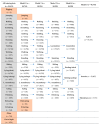The Use of Triaxial Accelerometers and Machine Learning Algorithms for Behavioural Identification in Domestic Dogs (Canis familiaris): A Validation Study
- PMID: 39338701
- PMCID: PMC11435861
- DOI: 10.3390/s24185955
The Use of Triaxial Accelerometers and Machine Learning Algorithms for Behavioural Identification in Domestic Dogs (Canis familiaris): A Validation Study
Abstract
Assessing the behaviour and physical attributes of domesticated dogs is critical for predicting the suitability of animals for companionship or specific roles such as hunting, military or service. Common methods of behavioural assessment can be time consuming, labour-intensive, and subject to bias, making large-scale and rapid implementation challenging. Objective, practical and time effective behaviour measures may be facilitated by remote and automated devices such as accelerometers. This study, therefore, aimed to validate the ActiGraph® accelerometer as a tool for behavioural classification. This study used a machine learning method that identified nine dog behaviours with an overall accuracy of 74% (range for each behaviour was 54 to 93%). In addition, overall body dynamic acceleration was found to be correlated with the amount of time spent exhibiting active behaviours (barking, locomotion, scratching, sniffing, and standing; R2 = 0.91, p < 0.001). Machine learning was an effective method to build a model to classify behaviours such as barking, defecating, drinking, eating, locomotion, resting-asleep, resting-alert, sniffing, and standing with high overall accuracy whilst maintaining a large behavioural repertoire.
Keywords: algorithm; behaviour classification; overall activity; random forest.
Conflict of interest statement
The authors declare no conflicts of interest.
Figures





References
-
- Menache S. Dogs and human beings: A story of friendship. Soc. Anim. 1998;6:67–86. doi: 10.1163/156853098X00069. - DOI
-
- Svartberg K., Forkman B. Personality traits in the domestic dog (Canis familiaris) Appl. Anim. Behav. Sci. 2002;79:133–155. doi: 10.1016/S0168-1591(02)00121-1. - DOI
-
- King T., Marston L.C., Bennett P.C. Breeding dogs for beauty and behaviour: Why scientists need to do more to develop valid and reliable behaviour assessments for dogs kept as companions. Appl. Anim. Behav. Sci. 2012;137:1–12. doi: 10.1016/j.applanim.2011.11.016. - DOI
-
- Diederich C., Giffroy J.-M. Behavioural testing in dogs: A review of methodology in search for standardisation. Appl. Anim. Behav. Sci. 2006;97:51–72. doi: 10.1016/j.applanim.2005.11.018. - DOI
MeSH terms
Grants and funding
LinkOut - more resources
Full Text Sources
Medical

